|
Displaying items by tag: Paris
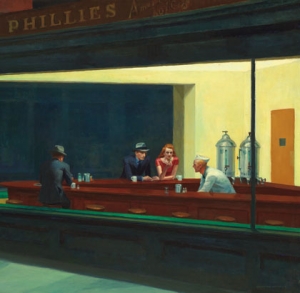
Best known for his paintings of stark diner scenes, snapshots of city life, and quiet portraits of the American landscape, there is much more to Edward Hopper’s (1882–1967) oeuvre than one might think. Referred to as a romantic, a realist, a symbolist, and even a formalist, the exhibition, Paintings by Edward Hopper (1882–1967) currently on view at the Grand Palais, Galeries Nationales in Paris aims to explore each facet of Hopper’s artistic identity.
Divided chronologically into two main parts, the first section of the exhibition covers Hopper’s early work from 1900 to 1924. During this time Hopper studied at the New York School of Art under Robert Henri, the founder of the Ashcan School of realism. Hopper also spent nearly a year in Paris in 1906, followed by shorter stays in 1909 and 1910.
The first part of the exhibition sets out to compare Hopper’s early work to that of his contemporaries as well as to the art he saw while in Paris. While in Europe, Hopper was influenced by such things as Degas’ original angles to Vermeer’s use of light. He was also moved by the soft, harmonious nature of Impressionism, which is reflected in his work from the time. This work is in sharp contrast to the almost gritty realism Hopper favored back in the United States.
1924 marked a turning point in Hopper’s career. After successful exhibitions of his watercolors of neo-Victorian houses in Gloucester, Massachusetts at the Brooklyn Museum and the Franck Rehn’s Gallery (New York), Hopper enjoyed commercial success and was able to fully devote his life to his art. Hopper’s watercolors mark the second section of the Grand Palais exhibition and feature the iconic paintings most people associate with the artist.
Curated by Didier Ottinger, assistant director of the MNAM – Center Pompidou, the exhibition of Hopper’s work will be on view through January 28, 2013.
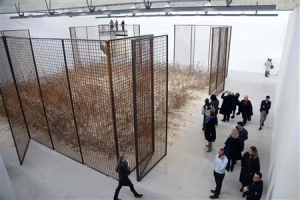
Two years after opening a Paris branch, Larry Gagosian will open a large gallery space in Le Bourget on the grounds of an airport. Designed by Pritzker Prize-winning French architect, Jean Nouvel, the space is located in a former 1950s hangar boasting 17,760 square feet. The inaugural exhibition at the two-level gallery will be by German painter and sculptor, Anselm Kiefer.
Gagosian, proprietor of the world’s largest commercial gallery network, planned for the Le Bourget opening to coincide with the annual Foir Internationale d’Art Contemporair (FIAC) in Paris, a contemporary art fair that brings in a hefty crowd of international art collectors.
Kiefer’s exhibition will feature five paintings and a huge field of handmade wheat stalks surrounded by a rust-colored steel cage. Titled Morgenthau Plan, the work refers to a plan devised in 1944 by U.S. Treasury Secretary, Henry Morgenthau, to disarm Germany by shutting down its industry and converting it to a strictly agricultural state. The hugely expansive space allows for such monumental installations. Nouvel, who designed the gallery in four months, put up four partition-like walls inside to create a central interior space and then used the area outside the walls and beneath the high ceilings to create display rooms and mezzanines.
France is home to some of the world’s top art collectors including chief executive officer of PPR, Francois-Henri Pinault, and French business magnate, Bernard Arnault, making it a prime destination for art dealerships. The new Gagosian Gallery will open on October 18 and Kiefer’s exhibition will run through January 2013.

Last week at Sotheby’s auction house in London, Gerhard Richter’s Abstraktes Bild (809–4) sold to a telephone bidder for $34.2 million, the highest price paid for a living artist’s work at auction. Previously owned by musician and collector, Eric Clapton, the abstract painting was estimated to bring $14.1 million to $18.8 million.
Alex Branczik, Senior Director and Head of the Evening Auction of Contemporary Art, said, “The combination of outstanding provenance and gold-standard quality in this sublime work by this blue-chip artist made for an historic auction moment. Gerhard Richter’s international appeal as one of the hottest Contemporary artists was once again confirmed this evening.”
The German postwar painter, best known for his abstract and figurative works, was recently the subject of a critically acclaimed retrospective, Gerhard Richter: Panorama, at the Tate Modern in London, the Pompidou Center in Paris, and the Staatlichen Museum in Berlin. After the show, the prices of Richter’s works have continued to climb.
Friday’s sale beat out Jasper Johns’ Flag painting from the 1960s, which brought $28.6 million at Christie’s in 2010, for a living artist at auction. Richter, 80, lives in Cologne, Germany.

When Timothy J. Standring, curator of painting and sculpture at the Denver Art Museum, suggested an exhibition of Vincent van Gogh’s work, it was quite a risk, mainly because the museum doesn’t own a single work by van Gogh. In addition, the Denver Art Museum’s strength lies in American Indian, pre-Columbian, and Spanish Colonial Art – not ideal holdings when attempting to swap works with European painting departments.
On October 21, six years after the thought first popped into Standring’s head, Becoming van Gogh will open to the public at the Denver Museum. The show will be comprised of 68 paintings and drawings by van Gogh and about another 20 works by artists he studied under.
A true labor of love, Standring traveled to 39 cities in Europe, at least 30 in North America, and another two in South America to do research, meet with scholars, view works, and negotiate with owners. Co-curated by Louis van Tilborgh, the exhibition evolved as the duo delved deeper into their research. Inspired by James Shapiro’s A Year in the Life of William Shakespeare: 1599, Standring wanted to capture the period when van Gogh became van Gogh. At first he thought a show of 30 oils and drawings done between 1887 and 1888 would be sufficient, but as his research progressed, Standring decided to explore van Gogh’s work from 1886–1888, the artist’s years in Paris.
Standring proceeded to make a checklist of all the works he wished to acquire. He made connections with curators at other museums, phoned friends and collectors. As he continued, the need for more works became apparent. Standring wanted to include early works from van Gogh’s time in the Netherlands and his later years in Provence. After countless phone calls, letters, negotiations, meetings, and planning, the exhibition came to fruition. Becoming van Gogh will be on view through January 20, 2013.
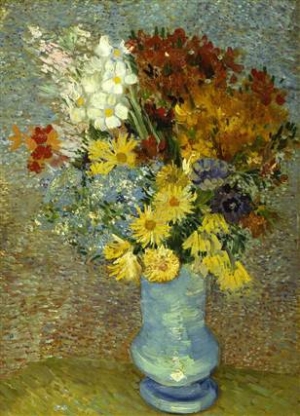
When Vincent van Gogh painted Flowers in a Blue Vase in 1887 in Paris, he chose a bright, cheery yellow for the flowers. As years passed, the vivid hue faded to a dull orange-gray and scientists have just found out that a coat of protective varnish is to blame.
After van Gogh’s death in 1890, the varnish was applied to preserve the work, a common practice at the time. However, when the paint mixed with the varnish, a chemical reaction occurred causing the colors to change.
Something seemed awry back in 2009 when Margje Leeuwestein, painting conservator at the Kröller-Müller Museum in the Netherlands, attempted a conversation treatment on the piece. An unusual gray crust containing cadmium yellow paint formed on the surface, signaling that they were dealing with more than just aging varnish which is known to darken over time.
As the painting had become increasingly brittle, experts at the Kröller-Müller Museum carefully took two microscopic paint samples from the original work and used X-ray beams to determine the chemical composition and structure where the paint and varnish met. A lead-sulfate compound, the result of photo-oxidation that separates cadmium and sulfate ions from that particular paint, was revealed. The researchers deduced that the negatively charged sulfate ions hooked up with the lead ions in the varnish to form anglesite, an opaque lead-sulfate compound that caused the color to transform.
By keeping the painting in lower light conditions and using more advanced varnish, the deterioration should be halted. The surprising findings will be chronicled in the upcoming issue of the scholarly journal, Analytical Chemistry.
When was the last time an expert from a top auction house dispensed with longtime allegiances and joined forces with someone from the enemy camp? In the fiercely competitive world of Sotheby’s and Christie’s, such an occurrence is rarer than a prized Vermeer.
But for months now there have been rumors that a new powerhouse partnership was in the works, one that would replace Giraud, Pissarro, Ségalot, the superprivate superdealer that pulled off so many big transactions and whose business began winding down soon after Franck Giraud, one of its partners, announced that he was leaving to “explore options inside the art world and out.”
The players making up this new venture, however, had been something of a guessing game.
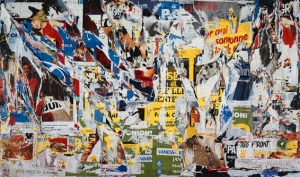
Think contemporary art in France and it is Paris’s still radical-looking Centre Pompidou that springs to mind. But for all Beaubourg’s status as a cultural powerhouse, the French have been anxious not to neglect their regions. In the past 30 years state-funded collections of contemporary art have quietly sprung up across France, bringing big-name artists such as Cindy Sherman and Sophie Calle to remote corners of the country, from Brittany to Provence.
The Fonds régionaux d’art contemporain (regional contemporary art funds, or Frac) were initiated by culture minister Jack Lang in 1982 as part of a decentralisation plan, the aim being to present the artists of the day to a diverse public in a spirit of fraternité. Now numbering 23, Frac are present in every French region, with more than 26,000 works by 4,200 French and international artists comprising the third largest public collection of contemporary art in France (behind the Paris-based Cnap, the Centre national des arts plastiques, and the Pompidou’s Musée national d’art moderne).
Scaffolding still blocks the view of Auguste Rodin’s monumental "Gates of Hell" at the entrance to Philadelphia's Rodin Museum. And Rodin's famous sculpture of the "Burghers of Calais" has yet to be cleaned up.
But the museum has undergone a $9 million renovation and is once again open to the public.
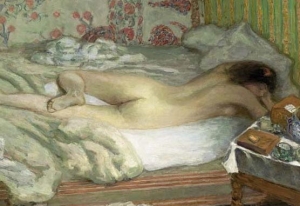
When Gertrude Stein published The Autobiography of Alice B. Toklas in 1933, all hell broke loose. Her hugely entertaining memoir tells the story of her early years in Paris, when her apartment in the rue de Fleurus became the most celebrated literary and artistic salon of the 20th century.
Readers were gripped by accounts of Gertrude’s Saturdays when visitors mingled with avant-garde artists, writers and collectors in rooms hung from floor to ceiling with the paintings by the artists she collected and promoted – including Renoir, Gauguin, Cézanne, Toulouse-Lautrec Matisse, Picasso and Juan Gris.
Her account of those years became an instant bestseller, but within the Stein family circle its publication caused consternation. For in it, Gertrude implied that she alone discovered Matisse and Picasso, downplaying the contribution of her two brothers Leo and Michael, and of Michael’s wife Sara. In truth, the four siblings acquired no fewer than 180 works by Matisse and Picasso alone, and all four were equally generous in providing financial and moral support to unknown artists. Leo was particularly scathing about the way his self-promoting sister wrote him out of the story. “Practically everything that she says of our activities before 1911 is false both in fact and implication… God what a liar she is!”
The massive exhibition devoted to the Stein Family that opens tomorrow at the Grand Palais sets the record straight. As the show documents in works of art, written and spoken words and scores of photographs, the Steins may not have been midwives at the birth of modern art, but they were certainly in the delivery room. What’s more, by admitting into their Saturday soirées anyone, whether they were interested in progressive painting or not, the Steins did as much as anyone to promote the culture of modernism. In the years when Picasso did not exhibit publically, the only way to see his work was to show up at an evening either with Gertrude and Leo in the rue de Fleurus or with Michael and Sara around the corner in the rue Madame. Matisse’s colour-saturated portraits and landscapes looked much less alarming when seen in a domestic setting, hanging alongside Renoirs or Gauguin, than they did in the scrum of the Salon d’Automne.
An educated, upper middle-class family originally from Pennsylvania, the Steins had money, but not a great deal of it, and were Jewish, but not religious. It was Leo who set the ball rolling when in 1902 he settled in Paris after two years studying art history in Florence. Shy and introspective, he was the driving force behind the collection and was able to recognise the ways in which young artists built on the achievements of the giants of French art in the 1870s such as Degas, Renoir, Cézanne and Manet.
This is could see that Picasso’s Boy Leading a Horse looked back to Cézanne’s Bathers, and Matisse’s Blue Nude, Memory of Biskra (1907) to the reclining nudes of Giorgione and Titian by way of Manet’s Olympia. It was Leo who (with Gertrude) bought Cézanne’s Woman with a Fan and he who acquired masterpieces from Picasso’s blue and rose periods. Leo defied conventional taste to purchase Matisse’s Lady in a Hat from the Salon d’Autumne of 1906 – not to mention owning the same artist’s Joy of Life, now in the Barnes Collection. Little wonder that Alfred Baar, the first director of the Museum of Modern Art, said of Leo that “for the two brief years between 1905 and 1907 he was possibly the most discerning art collector in the world”.
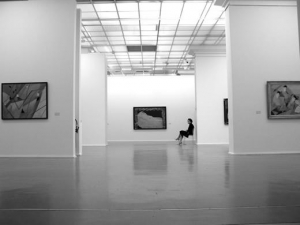
Three people are being held in connection with the theft of paintings worth at least 100 million dollars from a Paris gallery last year, but the works are still missing, a legal official said Saturday.
The three, a woman suspected of taking part in the theft and two people suspected of handling stolen goods, were arrested and charged over the robbery of the five paintings, by Henri Matisse, Pablo Picasso, Georges Braque, Ferdinand Leger and Amedeo Modigliani, and placed in custody on September 16, the official said.
A lone burglar sheared off a gate padlock and broke a window to get into the city-run Musee d'Art Moderne in the brazen operation during the night of May 19 last year.
The paintings were found to be missing just as the museum, a major tourist attraction near the Eiffel Tower, was about to open.
Paris mayor Bertrand Delanoe later said one of the museum's alarms had been "partly malfunctioning" since the end of March, and that it was still awaiting repair when the thieves struck.
The stolen Picasso alone -- the cubist "Dove with Green Peas," which the Spanish artist created in 1912 -- is worth some 25 million euros, according to the mayor's deputy for culture, Christophe Girard.
|
|
|
|
|